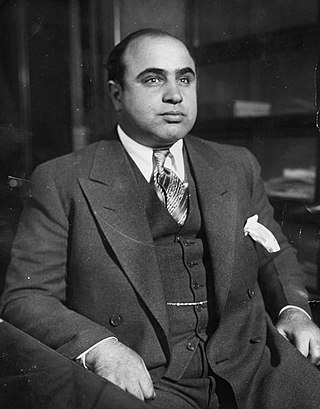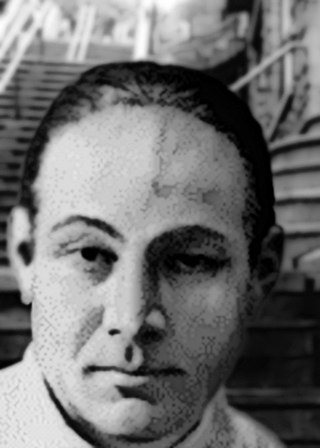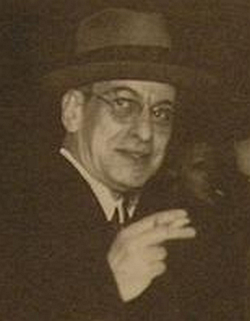
The Gambino crime family is an Italian-American Mafia crime family and one of the "Five Families" that dominate organized crime activities in New York City, within the nationwide criminal phenomenon known as the American Mafia. The group, which went through five bosses between 1910 and 1957, is named after Carlo Gambino, boss of the family at the time of the McClellan hearings in 1963, when the structure of organized crime first gained public attention. The group's operations extend from New York and the eastern seaboard to California. Its illicit activities include labor and construction racketeering, gambling, loansharking, extortion, money laundering, prostitution, fraud, hijacking, and fencing.

The Genovese crime family, also sometimes referred to as the Westside, is an Italian-American Mafia crime family and one of the "Five Families" that dominate organized crime activities in New York City and New Jersey as part of the American Mafia. The Genovese family has generally maintained a varying degree of influence over many of the smaller mob families outside New York, including ties with the Philadelphia, Cleveland, Patriarca, and Buffalo crime families.
Consigliere is a position within the leadership structure of the Sicilian, Calabrian, and Italian-American Mafia. The word was popularized in English by the novel The Godfather (1969) and its film adaptation. In the novel, a consigliere is an advisor or counselor to the boss, with the additional responsibility of representing the boss in important meetings both within the boss's crime family and with other crime families.

A crime boss, also known as a crime lord, mafia don, gang lord, gang boss, mob boss, kingpin, godfather, crime mentor, or criminal mastermind is the leader of a criminal organization.

The Five Families refer to five Italian American Mafia crime families that operate in New York City. In 1931, the five families were organized by Salvatore Maranzano following his victory in the Castellammarese War. Maranzano reorganized the Italian American gangs in New York City into the Maranzano, Profaci, Mangano, Luciano, and Gagliano families, which are now known as the Bonanno, Colombo, Gambino, Genovese, and Lucchese families, respectively. Each family had a demarcated territory and an organizationally structured hierarchy and reported to the same overarching governing entity.
The Colombo crime family is an Italian-American Mafia crime family and the youngest of the "Five Families" that dominate organized crime activities in New York City within the criminal organization known as the American Mafia. It was during Lucky Luciano's organization of the American Mafia after the Castellammarese War, following the assassinations of "Joe the Boss" Masseria and Salvatore Maranzano, that the gang run by Joseph Profaci became recognized as the Profaci crime family.

In the American and Sicilian Mafia, a made man is a fully initiated member of the Mafia. To become "made", an associate first must be Italian or of Italian descent and sponsored by another made man. An inductee will be required to take the oath of omertà, the Mafia code of silence and code of honor. After the induction ceremony, the associate becomes a "made man" and holds the rank of soldier in the Mafia hierarchy. Made men are the only ones who can rise through the ranks of the Mafia, from soldier to caporegime, consigliere, underboss, and boss.

The DeCavalcante crime family, also known as the North Jersey crime family or the North Jersey Mafia, is an Italian-American Mafia crime family that operates mainly in northern New Jersey, particularly in Elizabeth, Newark, West New York and the surrounding areas. The family is part of the nationwide criminal network known as the American Mafia.

Vittorio "Little Vic" Amuso is an American mobster and the boss of the Lucchese crime family. He was described as "The Deadly Don" by Assistant United States Attorney Charles Rose. Amuso's reign is considered one of the bloodiest periods in American Mafia history during the late 1980s and early 1990s, alongside his former underboss and close protégé Anthony Casso, who turned informer against him in 1994. Since the death of Colombo crime family boss Carmine Persico in March 2019, Amuso is currently the longest-serving crime family boss of the Five Families and American Mafia, dating back to 1987. Amuso has been serving a life sentence since 1992 and is currently located at the Federal Correctional Complex, Butner, in North Carolina, on murder and racketeering charges.

Anthony C. Strollo, also known as "Tony Bender", was a New York mobster who served as a high-ranking capo and underboss of the Genovese crime family for several decades.
The 116th Street Crew, also known as the Uptown Crew, is a faction of the Genovese crime family. In the early 1960s, Anthony Salerno became the caporegime of the 116th Street Crew and one of the most powerful captains in the Genovese family. Salerno based the crew in the Palma Boys Social Club located at 416 East 115th Street in East Harlem, Manhattan. By the late 1970s and early 1980s, the 116th Street Crew had absorbed and initiated many former members of the vicious East Harlem Purple Gang, an Italian-American murder for hire and drug trafficking gang operating in 1970s Italian Harlem and acting generally independently of the Mafia.
The Rochester crime family, also known as the Valenti crime family or the Rochester Mafia, was an Italian-American Mafia crime family based in Rochester, New York that was part of the American Cosa Nostra.
The Kansas City crime family, also known as the Civella crime family, the Kansas City Mafia or the Clique, is an Italian-American Mafia crime family based in Kansas City, Missouri.
Nicholas Angelo "Nicky Mouth" Santora was the reputed underboss of the Bonanno crime family.

A soldato or soldier is the first official level of both the Italian-American Mafia and the Sicilian Mafia in the formal Mafia hierarchy. It is also commonly used as a rank in other Italian criminal organizations, such as the 'Ndrangheta and Camorra. The promotion to the rank of soldier is an elevation in the chain of command from the associate level. The associate, who is not an initiated member of the Mafia, must prove himself to the family and take the oath of Omertà in order to become an initiated made man and therefore rise to the rank of soldato.

The Lucchese crime family is an Italian-American Mafia crime family and one of the "Five Families" that dominate organized crime activities in New York City, within the nationwide criminal phenomenon known as the American Mafia. Members refer to the organization as the Lucchese borgata; borgata is Mafia slang for criminal gang, which itself was derived from a Sicilian word meaning close-knit community. The members of other crime families sometimes refer to Lucchese family members as "Lukes".
The American Mafia, commonly referred to in North America as the Italian-American Mafia, the Mafia, or the Mob, is a highly organized Italian-American criminal society and organized crime group. In North America, the organization is often colloquially referred to as the Italian Mafia or Italian Mob, though these terms may also apply to the separate yet related Sicilian Mafia or other organized crime groups in Italy, or ethnic Italian crime groups in other countries. The organization is often referred to by its members as Cosa Nostra and by the American government as La Cosa Nostra (LCN). The organization's name is derived from the original Mafia or Cosa Nostra, the Sicilian Mafia, with "American Mafia" originally referring simply to Mafia groups from Sicily operating in the United States.

Francesco Paolo Augusto "Frank" Cali, also known as "Franky Boy", was an American mobster and the acting boss of the Gambino crime family of New York City at the time of his death. Law enforcement considered Cali to have been the Gambinos' "ambassador to Sicilian mobsters" and had linked him to the Inzerillo Mafia family from Palermo. According to Assistant U.S. Attorney Joseph Lipton, he was "seen as a man of influence and power by organized crime members in Italy." Cali was shot and killed outside his home in Staten Island on March 13, 2019, in connection with the killer's belief in the QAnon conspiracy theory.
This is a glossary of words related to the Mafia, primarily the Italian American Mafia and Sicilian Mafia.
- administration: the top-level "management" of an organized crime family -- the boss, underboss and consigliere.
- associate: one who works with mobsters, but has not been asked to take the vow of Omertà; an almost confirmed, or made guy.
- bagman: a person or paymaster designated to collect or distribute illicitly gained money.
- barone: a baron or landlord.
- books, the: a phrase indicating membership in the family. If there is a possibility for membership, then the books are open. If not, the books are closed.
- boss: the head of the family who runs the operation. The boss also gets points from all family business; also see don, chairman.
- bridge: threat of death; e.g. "our former friend is walking across the bridge".
- button or becoming a button man: a mafia hit man; or someone who has become a made man.
- capo: the family member who leads a crew; short for caporegime or capodecina.
- capo dei capi: "boss of all [the] bosses" is a phrase used mainly by the media, public and the law enforcement community to indicate a supremely powerful crime boss in the Sicilian or American Mafia who holds great influence over the whole organization.
- captain: a capo.
- cement shoes: a method of murder or body disposal, usually associated with criminals such as the Mafia or gangs. It involves weighting down the victim, who may be dead or alive, with concrete and throwing them into water in the hope the body will never be found.
- clip: to murder; also to whack, hit, pop, burn, ice, put a contract out on.
- code of silence: not ratting on one's colleagues once one has been pinched -- no longer a strong virtue in organized crime families. Also, see omertà.
- comare: literally "godmother" in Southern Italian slang, usually pronounced "goomah" or "goomar" in American English: a Mafia mistress.
- confirm: to be made; see made guy.
- connected guy: an associate
- consigliere: the family adviser, who is always consulted before decisions are made.
- Cosa Nostra (Our thing): mob term for the family or Mafia
- crank: speed; in particular, crystal meth.
- crew: the group of soldiers under the capo's command.
- cugine: a young soldier striving to be made.
- don: the head of the family; see boss.
- earner: a member who brings in much money for the family.
- eat alone: to keep for oneself; to be greedy.
- family: an organized crime clan.
- forget about it (often pronounced "fuggedaboutit"): An exclamation; as the title character explains in Donnie Brasco:
"Forget about it" is, like, if you agree with someone, you know, like "Raquel Welch is one great piece of ass. Forget about it!" But then, if you disagree, like "A Lincoln is better than a Cadillac? Forget about it!" You know? But then, it's also like if something's the greatest thing in the world, like, "Minchia! Those peppers! Forget about it!" But it's also like saying "Go to hell!" too. Like, you know, like "Hey Paulie, you got a one-inch pecker?" and Paulie says "Forget about it!" Sometimes it just means "Forget about it."
- friend: "a friend of mine" is an associate, "a friend of ours" is a made man.
- G: a grand; a thousand dollars; also see large.
- garbage business: euphemism for organized crime.
- Golden Age: The days before RICO.
- Goodfella: A member of the Mafia.
- goomar or goomah: Americanized form of comare, a Mafia mistress.
- goombah: an associate, especially a senior member of a criminal gang.
- heavy: packed, carrying a weapon.
- hit: to murder; also see whack.
- initiation or induction: becoming a made man.
- juice: the interest paid to a loan shark for the loan; also see vig.
- kick up: give a part of the income to the next up in the command chain.
- lam: To lay down, go into hiding.
- large: a thousand, a grand, a G.
- LCN: abbreviation for La Cosa Nostra.
- lupara bianca: a journalistic term to indicate a Mafia slaying done in such a way that the victim's body is never found.
- made man: an inducted member of the family.
- make one's bones: gain credibility by killing someone.
- mock execution: to whip someone into shape by frightening them.
- mattresses, going to, taking it to, or hitting the: going to war with a rival clan or family.
- message job: placing the bullet in someone's body such that a specific message is sent to that person's crew or family; see through the eye and through the mouth.
- mob, the: a single organized crime family; or all organized crime families together.
- mobbed up: connected to the mob.
- mobster: one who is in the mob.
- oath: becoming inducted as a made man.
- Omertà: to take a vow of silence in the Mafia, punishable by death if not upheld.
- one-way ride or taking someone for a ride: underworld for an execution method
- outfit: a clan, or family within the Mafia.
- old country: refers to Italy when used by members of the American Mafia
- painting houses: murdering someone
- pass: A reprieve from being whacked.
- paying tribute: giving the boss a cut of the deal.
- pinched: to get caught by the cops or federal agents.
- points: percent of income; cut.
- program, the: The Witness Protection Program.
- rat: someone who turns informant, snitches or squeals after having been pinched.
- RICO: Racketeer Influenced and Corrupt Organizations Act. Passed in 1970 to aid the American government in clamping down on organized crime activities, its scope has since been broadened to prosecute insider traders.
- sent for: to be ordered to a meeting with other mob members and being whacked.
- shakedown: to blackmail or try to get money from someone; also to give someone a scare.
- shy: the interest charged on loans by loan sharks.
- shylock business: the business of loansharking.
- sitdown: a meeting, esp. with another family.
- soldier: the bottom-level member of an organized crime family who is made.
- spring cleaning: cleaning up, hiding or getting rid of evidence.
- straighten out, getting straightened out: becoming a made guy.
- tax: to take a percentage of someone's earnings.
- The Commission and the Sicilian Mafia Commission: two bodies, Italian-American and the Sicilian respectively, of leading Mafia members to decide on important questions concerning the actions of, and settling disputes within the Mafia.
- This Thing of Ours (Cosa Nostra): a mob family, or the entire mob.
- through the eye: a message job through the eye to say "We're watching you!"
- through the mouth: a message job through the mouth to indicate that someone WAS a rat.
- underboss: the second in command to the boss.
- vig: Vigorish abbr. the house's or bookie's take in gambling or the interest paid to a loan shark for the loan; also see juice.
- waste management business: euphemism for organized crime.
- whack: to murder; also clip, hit, pop, burn, put a contract out.
- wiseguy: a made man.
- zips: is a slang term often used as a derogatory slur by Italian American and Sicilian American mobsters in reference to newer immigrant Sicilian and Italian mafiosi.
The Bonanno crime family is an Italian-American Mafia crime family and one of the "Five Families" that dominate organized crime activities in New York City as part of the criminal phenomenon known as the American Mafia.










